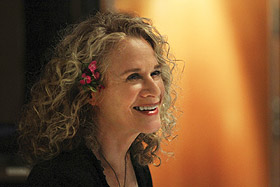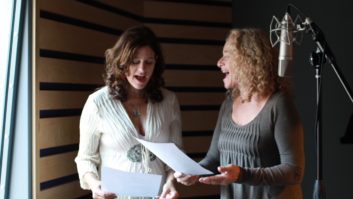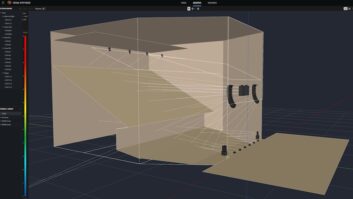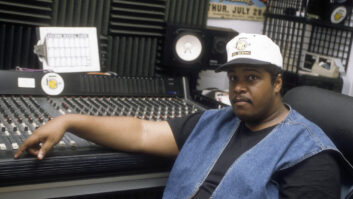
Photos: Elissa Kline
Louise Goffin describes the relationship between artist and producer as being “a little like the recording artist is the child and the producer is the adult.” It’s a bit ironic, considering that Goffin, a longtime recording artist/composer, just produced her first full-length album project—for her mom, Carole King.
The record is King’s first holiday album—a collection of nuggets and a few originals—that got rolling while she was working intently on her memoirs in 2009, entitled A Natural Woman, scheduled for release in April 2012. “Her main focus was writing her book,” Goffin says. “But her manager at the time, Lorna Guest, had been talking to her about doing a record like this for some time. She needed somebody she could trust, as she came out of that protective solitude place of writing her life story and back into the studio. She felt comfortable with me, and it was a great pairing in that, because of her trust in me, I was able to create an environment that was welcoming to her so she could be her best.”

Goffin says that even as she and King found themselves choosing well-loved material like “Sleigh Ride,” “My Favorite Things,” “Carol of the Bells” and “Have Yourself a Merry Little Christmas,” she knew she wanted to find a new way into those songs. “I took it as a challenge to come up with an interesting angle,” she says. “I originally thought, ‘I’m going to make a very arty, left-of-center holiday record.’”
Listening to the album, the arrangements, which are nicely varied—sometimes more piano-and-voice-centered; sometimes fully orchestrated with horns, strings and choirs of angels; sometimes tropical—really support what actually does make the record unique, which is King herself. The phrasing and harmonics of her singing style are so familiar and yet still so singular.
“The type of writing and performance she does, she invented that,” says engineer Nathaniel Kunkel, who recorded most, and mixed all, of the album. “It’s really just an honor to watch her and record her voice.”

Mother and daughter at work in the studio: Louise Goffin (left) and Carole King
One of the tracks, a jazz-y version of “The Chanukah Prayer,” was produced in producer and composer Lee Curreri’s studio, Xacca Sounds (Marina Del Rey, Calif.), but most of the tracking happened either in Studio D at The Village (West L.A.), where Goffin also has a long-term lock on a personal room, or in Allen Sides’ Record One (Sherman Oaks, Calif.).
“I think the thing that made this record come out so nice is that it was a very traditional kind of approach,” Kunkel observes. “It isn’t that we didn’t build tracks off of piano/vocal overdubs, but we did that when the piano/vocal overdub was just too spectacular not to use. For the most part, it was like, ‘This is the song; let’s get some great musicians together and tell them about our vision for it, and let’s go in the studio and cut it.’ Almost all of the tunes are real band-in-the-studio recordings.”
Kunkel recorded to Pro Tools at 96k, usually via the Neve 88R board in Village D. The sessions took place in bursts over the course of two years, but Kunkel always found the right Neumann U67 mic. “If the studio didn’t have one, we would rent one,” he says. “We would gravitate toward stock-diaphragm U67s—not modified stuff—because on her voice I wanted to get as much richness out of it as I could. And then in her vocal chain, we would go to a GML 2020 through the GML vocal channel, and we’d use that as a mic pre and a filter.
“The whole thing was recorded with no compression,” Kunkel continues. “We kept it really open and natural, and addressed that stuff in mixing so the recording process was extraordinarily organic. I had Class-A mic pre’s and good microphones, and very little EQ.”
Kunkel could not clear his schedule for every session, though; while he was tracking a new Lyle Lovett album, Niko Bolas handled a few of the tunes, including Booker T. Jones’ upbeat soul song “Every Day Will Be Like a Holiday.” “He made the horns on that sound like a great old Stax record,” Kunkel says of Bolas’ contribution. “It sounded fantastic!”
Kunkel and Goffin mixed on an Avid ICON, mostly in Kunkel’s Studio Without Walls, but also in KMA Music in Times Square. Kunkel’s monitors of choice are either JBL LSR models or ATC 25s. However, he humbly insists that equipment is beside the point when you’re working with an artist like King.
“It’s like the first experience I had recording James Taylor,” he says. “I was so nervous and worried about it, and then he got in front of a 57 and started singing, and I went, ‘Oh, I see, it doesn’t matter what I put in front of him.’ We can convince ourselves as engineers that we play such a major role in the way records sound, and then somebody like Carole King walks up to a piano and plays and sings, and you go, ‘Oh, I see…There’s really nothing I can do to mess this up!’”
Carole King Working in the Studio Video




